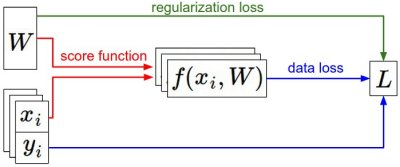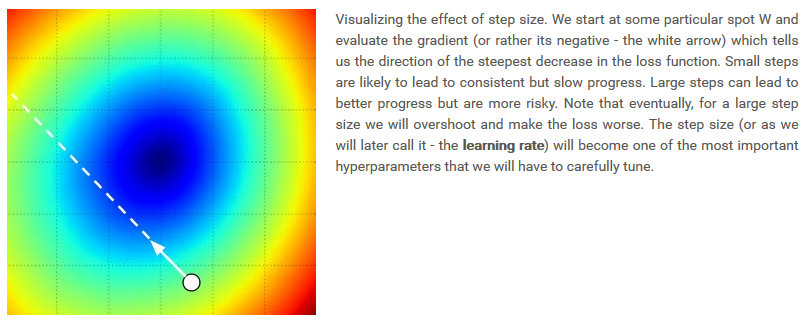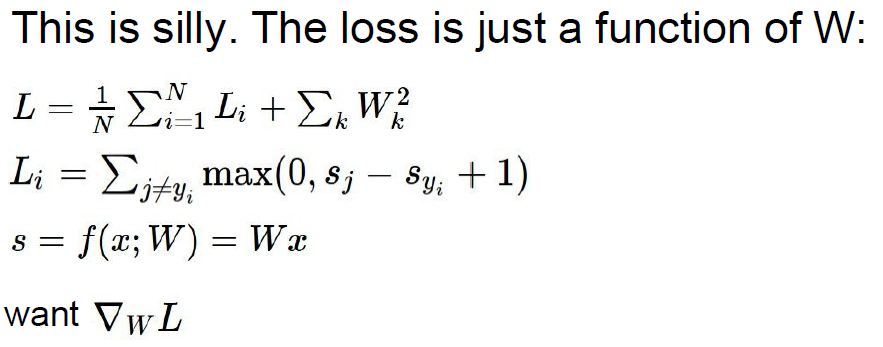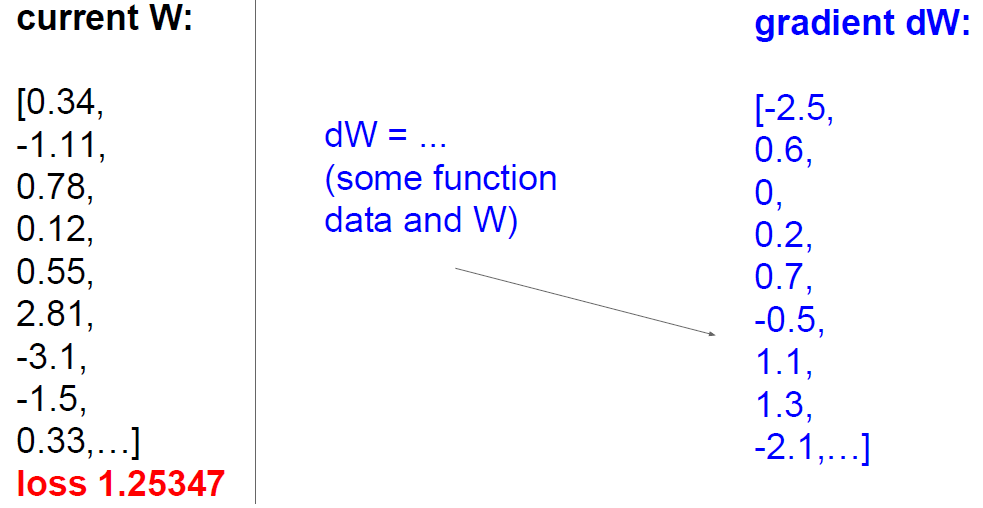优化的目的是找到合适的W使loss最小,最常用也是最好的办法是Gradient descent。

输入参数xi、yi是固定的,W是变化的。
前向传播过程:根据score function计算class score并保存在f()函数中;损失函数包括两部分,(1)根据f和y计算的data loss,(2)regularization loss,是关于W的函数。
根据变化的W,计算gradient。
下面介绍如何利用梯度计算loss,实现优化W的目的。
解决方法:gradient check。
首先计算Numerically with finite differences,然后计算Analytically with calculus,检验利用Numerically with finite differences计算的loss的准确性。(There are two ways to compute the gradient: A slow, approximate but easy way (numerical gradient), and a fast, exact but more error-prone way that requires calculus (analytic gradient).)
Computing the gradient numerically with finite differences
利用下面公式,并附代码:
def eval_numerical_gradient(f, x):
"""
a naive implementation of numerical gradient of f at x
- f should be a function that takes a single argument
- x is the point (numpy array) to evaluate the gradient at
"""
fx = f(x) # evaluate function value at original point
grad = np.zeros(x.shape)
h = 0.00001
# iterate over all indexes in x
it = np.nditer(x, flags=['multi_index'], op_flags=['readwrite'])
while not it.finished:
# evaluate function at x+h
ix = it.multi_index
old_value = x[ix]
x[ix] = old_value + h # increment by h
fxh = f(x) # evalute f(x + h)
x[ix] = old_value # restore to previous value (very important!)
# compute the partial derivative
grad[ix] = (fxh - fx) / h # the slope
it.iternext() # step to next dimension
return grad通过h的变化得到x,并计算x下的梯度,f(x)对应于L(w+aw),也就是变化w时候的loss的梯度。
计算loss,受到参数step_size(即learning rate)的限制:给定W,计算loss变化的梯度,这个梯度可以显示loss函数下降的最快的方向,但是不能提供下降到多大程度合适。step_size过大时,收敛速度加快,但是会出现过拟合,是loss变得更坏;当step_size过小时,收敛速度太慢。
Computing the gradient analytically with Calculus
通过反向传播计算analytic gradient。
Gradient Descent
梯度下降的方法是现在最流行的进行优化的方法,下面是代码。
# Vanilla Gradient Descent
while True:
weights_grad = evaluate_gradient(loss_fun, data, weights)
weights += - step_size * weights_grad # perform parameter updateMini-batch gradient descent.
利用此方法的情况是,样本很大,所以可以去其中的一部分来进行优化。
常用参数设置:
batch_size=32/64/128/…(2的幂)
power=2
# Vanilla Minibatch Gradient Descent
while True:
data_batch = sample_training_data(data, 256) # sample 256 examples
weights_grad = evaluate_gradient(loss_fun, data_batch, weights)
weights += - step_size * weights_grad # perform parameter update极端情况:当batch_size=1时,这个过程也被称为Stochastic Gradient Descent (SGD) (or also sometimes on-line gradient descent),但是这种方法不常用,因为计算100个例子的梯度比把1个例子计算100次对于优化更有效。








 这篇博客探讨了在优化过程中如何使用Gradient Descent,包括Numerical和Analytical两种计算梯度的方法,并介绍了Mini-batch Gradient Descent。通过理解梯度下降,我们可以有效地调整模型参数,以减小损失函数并优化神经网络模型。文章还强调了step_size(学习率)的重要性,以及在不同情况下选择合适的学习率策略。
这篇博客探讨了在优化过程中如何使用Gradient Descent,包括Numerical和Analytical两种计算梯度的方法,并介绍了Mini-batch Gradient Descent。通过理解梯度下降,我们可以有效地调整模型参数,以减小损失函数并优化神经网络模型。文章还强调了step_size(学习率)的重要性,以及在不同情况下选择合适的学习率策略。


















 7934
7934

 被折叠的 条评论
为什么被折叠?
被折叠的 条评论
为什么被折叠?








